| Look up volcanogenic in Wiktionary, the free dictionary. |
Volcanogenic means "created by a volcano. It may refer to:
| Look up volcanogenic in Wiktionary, the free dictionary. |
Volcanogenic means "created by a volcano. It may refer to:

Sphalerite is a sulfide mineral with the chemical formula (Zn,Fe)S. It is the most important ore of zinc. Sphalerite is found in a variety of deposit types, but it is primarily in sedimentary exhalative, Mississippi-Valley type, and volcanogenic massive sulfide deposits. It is found in association with galena, chalcopyrite, pyrite, calcite, dolomite, quartz, rhodochrosite, and fluorite.
Hydrothermal circulation in its most general sense is the circulation of hot water. Hydrothermal circulation occurs most often in the vicinity of sources of heat within the Earth's crust. In general, this occurs near volcanic activity, but can occur in the shallow to mid crust along deeply penetrating fault irregularities or in the deep crust related to the intrusion of granite, or as the result of orogeny or metamorphism.

In chemistry, a suspension is a heterogeneous mixture of a fluid that contains solid particles sufficiently large for sedimentation. The particles may be visible to the naked eye, usually must be larger than one micrometer, and will eventually settle, although the mixture is only classified as a suspension when and while the particles have not settled out.
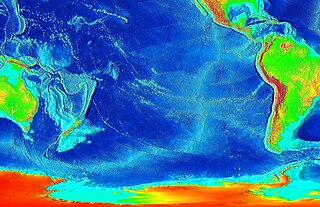
The East Pacific Rise is a mid-ocean ridge, a divergent tectonic plate boundary located along the floor of the Pacific Ocean. It separates the Pacific Plate to the west from the North American Plate, the Rivera Plate, the Cocos Plate, the Nazca Plate, and the Antarctic Plate. It runs south from the Gulf of California in the Salton Sea basin in Southern California to a point near 55° S, 130° W, where it joins the Pacific-Antarctic Ridge trending west-southwest towards Antarctica, near New Zealand. Much of the rise lies about 3200 km (2000 mi) off the South American coast and rises about 1,800–2,700 m (6,000–9,000 ft) above the surrounding seafloor.
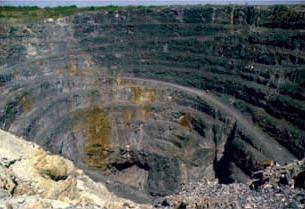
Volcanogenic massive sulfide ore deposits, also known as VMS ore deposits, are a type of metal sulfide ore deposit, mainly copper-zinc which are associated with and created by volcanic-associated hydrothermal events in submarine environments.

A volcanogenic lake is a lake formed as a result of volcanic activity. They are generally a body of water inside an inactive volcanic crater but can also be large volumes of molten lava within an active volcanic crater and waterbodies constrained by lava flows, pyroclastic flows or lahars in valley systems. The term volcanic lake is also used to describe volcanogenic lakes, although it is more commonly assigned to those inside volcanic craters.

Kidd Mine or Kidd Creek Mine is an underground base metal mine 24 km (15 mi) north of Timmins, Ontario, Canada. It is owned and operated by Swiss multinational Glencore Inc. The mine was discovered in 1963 by Texas Gulf Sulfur Company. In 1981 it was sold to Canada Development Corporation, then sold in 1986 to Falconbridge Ltd., which in 2006 was acquired by Xstrata, which in turn merged with Glencore in 2013. Ore from the Kidd Mine is processed into concentrate at the Kidd Metallurgical Site, located 27 km (17 mi) southeast of the mine, which until 2010 also smelted the ore and refined the metal produced. Following the closure of the majority of the Met Site, concentrate is now shipped to Quebec for processing. Kidd Mine is the world's deepest copper-zinc mine.
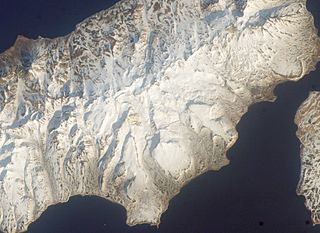
Vernadskii Ridge is a volcanic group located in the northern part of Paramushir Island, Kuril Islands, Russia. It is named after Russian scientist Vladimir Vernadsky. The Vernadskii Ridge together with Ebeko is one of the volcanoes on Paramushir that have erupted after the last glacial age, and both of them form one of Paramushir's volcanic ridges; during the last ice age glaciers from the Vernadskii Ridge merged the island with Shumshu island. A hydrothermal system is associated with the Vernadskii Ridge, which has temperatures of 180–260 °C (356–500 °F). Metasomatic alteration of country rock has taken place.

Seafloor massive sulfide deposits or SMS deposits, are modern equivalents of ancient volcanogenic massive sulfide ore deposits or VMS deposits. The term has been coined by mineral explorers to differentiate the modern deposit from the ancient.
Kuroko may also refer several fictional characters:
Obulavaripalle mandal is one of the 50 mandals in Annamayya district of the Indian state of Andhra Pradesh. It is under the administration of Rajampeta revenue division, with its headquarters at Mangampet town. The mandal is bounded by Kodur, Chitvel and Pullampeta mandals. Construction of a new railway line Obulavaripalle–Krishnapatnam section connecting Obulavaripalle railway station to Krishnapatnam port is in progress.
The Densuş-Ciula Formation is a geological formation in Romania whose strata date back to the Late Cretaceous. It forms part of the Hațeg Island assemblage. Dinosaur remains are among the fossils that have been recovered from the formation. It is divided up into three members, the lower member is noted for high content of volcanogenic material and is poorly fossiliferous. While the Middle member consists of silty mudstones, sandstones and conglomerates containing volcanogenic clasts and is richly fossiliferous, while the upper member consists of matrix supported red conglomerates and is poorly fossiliferous.
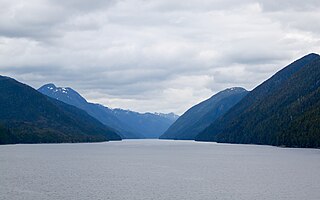
Grenville Channel is a strait on the North Coast of British Columbia, Canada, between Pitt Island and the mainland to the south of Prince Rupert. It is part of the Inside Passage shipping route, about 45 nautical miles long and is 0.2 nautical miles wide at its narrowest point.
The Bathurst Mining Camp is a mining district in northeast New Brunswick, Canada, centred in the Nepisiguit River valley, and near to Bathurst. The camp hosts 45 known volcanogenic massive sulfide (VMS) deposits typical of the Appalachian Mountains. Some of the ore is smelted at the Belledune facility of Xstrata. Although the primary commodity is zinc, the massive-sulphide ore body produces lead, zinc, copper, silver, gold, bismuth, antimony and cadmium.
A tsunami is a series of water waves caused by the displacement of a large volume within a body of water, often caused by earthquakes, or similar events. This may occur in lakes as well as oceans, presenting threats to both fishermen and shoreside inhabitants. Because they are generated by a near field source region, tsunamis generated in lakes and reservoirs result in a decreased amount of warning time.
VMS may refer to:
Bursaite is a sulfosalt of the lillianite family. It has the formula Pb5Bi4S11 and orthorhombic structure. Bursaite is named after Bursa Province, Turkey, where it was discovered. It is generally located in regions rich in sulfur and commonly occurs alongside other sulfosalts. Its areas of formation are usually those that were once volcanogenic because it is generally aggregated with other minerals under intense heating. It was officially delisted as a mineral in 2006, being cited as an intergrowth of two other sulfosalts.
Periodon is a genus of conodonts which existed in what is now Canada, Iran, Argentina, China, Russia, and the United States during the Ordovician Period. It was described by Hadding in 1913, and the type species is P. aculeatus.
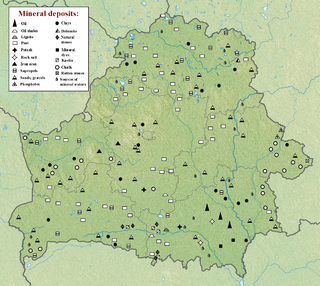
The geology of Belarus began to form more than 2.5 billion years ago in the Precambrian, although many overlying sedimentary units deposited during the Paleozoic and the current Quaternary. Belarus is located in the eastern European plain. From east to west it covers about 650 kilometers while from north to south it covers about 560 kilometers, and the total area is about 207,600 square kilometers. It borders Poland in the north, Lithuania in the northwest, Latvia and Russia in the north, and Ukraine in the south. Belarus has a planar topography with a height of about 160 m above sea level. The highest elevation at 346 meters above sea level is Mt. Dzerzhinskaya, and the lowest point at the height of 80 m is in the Neman River valley.
A sulfide deposit is an ore body or rock containing a great deal of sulfide minerals.